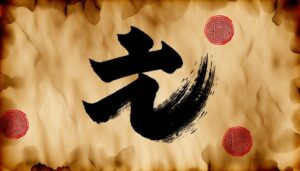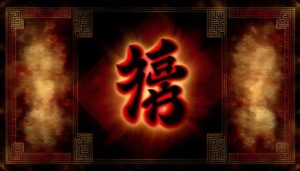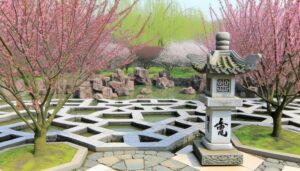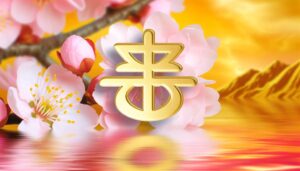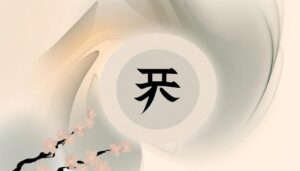How Does the Chinese Symbol for Never Give Up Look?
The Chinese symbol for 'never give up' is deeply ingrained in ancient philosophical traditions, prominently featuring characters such as 勇 (yǒng) for courage and 毅 (yì) for perseverance. Rooted in Confucian and Taoist teachings, these symbols emphasize enduring hardship with resilience and determination.
Chinese calligraphy captures this enduring spirit, translating profound cultural values into visually expressive art forms. These principles have inspired countless individuals, from historical figures to modern entrepreneurs, showcasing the timeless message of unwavering resolve.
Discover more about how these ancient symbols continue to inspire and guide people in contemporary times.

Key Takeaways
- The Chinese symbol for "never give up" embodies perseverance, resilience, and determination.
- Characters like 勇 (yǒng) and 毅 (yì) are central to the concept of not giving up.
- Calligraphy of the symbol visually represents cultural and philosophical significance.
- Rooted in ancient texts like the 'Analects of Confucius' and 'Tao Te Ching'.
- It inspires strength and determination in diverse contexts, from health challenges to entrepreneurship.
Historical Origins
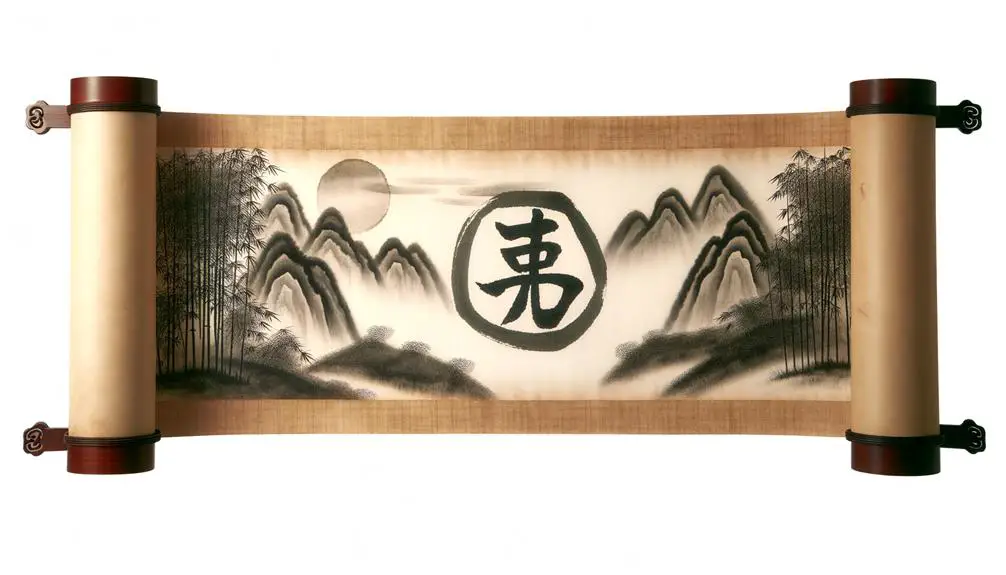
The historical origins of the Chinese symbol for 'never give up' can be traced back to ancient philosophical texts and cultural traditions that emphasize perseverance and resilience.
Central to Confucianism and Taoism, these values were encapsulated in characters such as 勇 (yǒng, meaning courage) and 毅 (yì, meaning persistence).
Ancient Chinese literature, including the 'Analects of Confucius' and Laozi's 'Tao Te Ching,' frequently highlighted the virtue of enduring hardship with unwavering determination.
Additionally, Chinese folklore and historical narratives often celebrated heroic figures who embodied these principles, further embedding them into the cultural psyche.
These ideological underpinnings eventually coalesced into the modern symbol that represents a steadfast spirit, integral to Chinese identity and cultural heritage.
Symbolic Meaning
Building upon these historical origins, the Chinese symbol for 'never give up' encapsulates profound layers of cultural significance and philosophical depth. This symbol integrates the essence of perseverance, resilience, and unwavering determination, which are deeply rooted in Chinese culture and philosophy. It conveys a timeless message of enduring hardship with steadfast resolve. Below is a table elucidating specific aspects of its symbolic meaning:
| Aspect | Description |
|---|---|
| Perseverance | Continuous effort despite difficulties |
| Resilience | Ability to recover from setbacks |
| Determination | Firmness of purpose |
| Endurance | Sustaining prolonged physical or mental effort |
Understanding these elements provides insight into the broader cultural and philosophical context, emphasizing the importance of not giving up in the face of adversity.
Cultural Significance
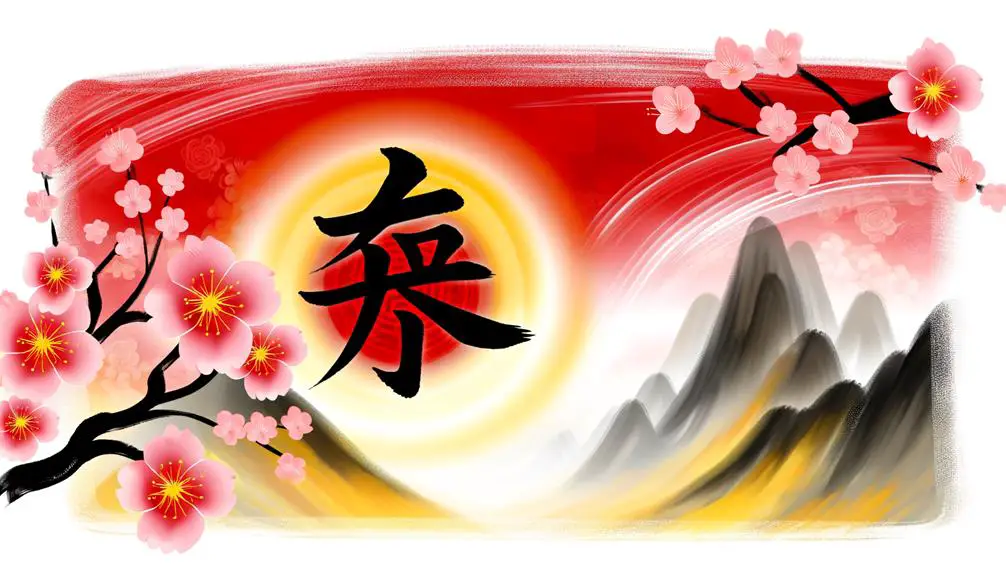
The phrase 'never give up' resonates deeply with traditional Chinese values, reflecting principles such as perseverance and resilience inherent in Confucian ethics.
In Chinese calligraphy, the visual representation of this concept is not merely artistic but also a conduit of cultural and philosophical significance, where each stroke embodies historical and moral teachings.
This symbolic expression underscores the collective emphasis on enduring hardship and aspiring for excellence, central tenets in Chinese cultural heritage.
Traditional Chinese Values
Embedded within the phrase 'Never Give Up' is a profound reflection of the traditional Chinese values of perseverance, resilience, and unwavering determination. These virtues are deeply ingrained in Chinese culture, drawing from millennia of philosophical thought and historical practice. The cultural significance of these values can be traced back to Confucian and Taoist teachings, which emphasize moral integrity and steadfastness.
| Value | Chinese Term | Cultural Insight |
|---|---|---|
| Perseverance | 恒心 (Héng xīn) | Integral to overcoming adversity and achieving goals. |
| Resilience | 韧性 (Rèn xìng) | Essential for enduring hardships and bouncing back. |
| Determination | 决心 (Jué xīn) | Essential for maintaining focus and pursuing aspirations. |
These principles underscore the importance of inner strength and fortitude in Chinese tradition.
Symbolism in Calligraphy
Calligraphy, an esteemed art form in Chinese culture, imbues each character with deep symbolic meaning and historical resonance. The practice transcends mere writing, transforming ideograms into vessels of cultural heritage and philosophical depth.
Each stroke and flourish in Chinese calligraphy encapsulates centuries of tradition, reflecting the essence of concepts like resilience and perseverance. The character for 'never give up' (永不放弃, yǒng bù fàng qì) is more than a phrase; it is a symbol of enduring human spirit, meticulously crafted to inspire and fortify.
The discipline required in calligraphy mirrors the persistence the symbol advocates, making it a potent cultural artifact. This elegant interplay of form and meaning underscores calligraphy's profound cultural significance and its role in conveying timeless values.
Calligraphy Styles
Calligraphy styles play a pivotal role in expressing the Chinese symbol for 'Never Give Up.' Traditional techniques such as Kaishu (regular script) and Caoshu (cursive script) showcase historical depth and artistic discipline.
Modern influences, on the other hand, bring a contemporary flair to the symbol, often blending classical elements with innovative forms to appeal to a broader audience. This intersection of old and new highlights the evolving nature of Chinese calligraphy while preserving its cultural essence.
Traditional Calligraphy Techniques
Renowned for its intricate aesthetics and cultural significance, traditional Chinese calligraphy encompasses several distinct styles, each reflecting historical evolution and philosophical underpinnings.
Among these, Kai Shu (Regular Script) is celebrated for its clarity and balanced structure, ideal for beginners.
Xing Shu (Running Script) merges formality with fluidity, embodying dynamism and personal expression.
Cao Shu (Cursive Script) emphasizes speed and spontaneity, often requiring advanced skill to decipher.
Li Shu (Clerical Script) traces back to the Han Dynasty, noted for its wide, flat strokes.
Finally, Zhuan Shu (Seal Script) is the oldest style, characterized by its symmetrical and archaic forms.
Each style offers unique insights into Chinese culture and history, contributing to the art's enduring legacy.
Modern Calligraphy Influences
Integrating elements from both traditional practices and contemporary aesthetics, modern Chinese calligraphy continues to evolve, reflecting the dynamic interplay between cultural heritage and artistic innovation.
Modern calligraphers often experiment with bold strokes, abstract forms, and unconventional materials, thereby broadening the scope of expression. Influenced by global art movements, these artists transcend classical conventions while still honoring the essence of ancient techniques.
This fusion results in works that are not only visually striking but also imbued with profound cultural significance. The symbol for 'Never Give Up' (永不放弃) exemplifies this trend, as its depiction ranges from minimalist interpretations to elaborate, dynamic compositions.
Ultimately, modern calligraphy serves as a bridge connecting historical legacy with contemporary artistic exploration.
Modern Usage

In contemporary settings, the Chinese symbol for 'never give up' is frequently employed in motivational contexts, branding, and personal tattoos to convey resilience and perseverance. This symbol, deeply rooted in Chinese cultural philosophy, serves as a powerful emblem of determination. Its usage spans various modern applications, reflecting both historical reverence and contemporary relevance.
| Usage | Context |
|---|---|
| Motivational Posters | Inspirational Settings |
| Branding | Corporate Identity |
| Personal Tattoos | Individual Expression |
| Merchandise | Consumer Goods |
Brands increasingly incorporate this symbol to foster a message of enduring strength, while individuals often choose it for tattoos as a personal mantra. The symbol's versatility and profound meaning make it a timeless choice in diverse modern contexts.
Personal Stories
Many individuals have embraced the Chinese symbol for 'never give up' as a profound personal mantra, with their stories illustrating the symbol's transformative impact on their lives.
Rooted in centuries-old principles of resilience and perseverance, these personal narratives often reflect a deep cultural appreciation for enduring hardship.
For instance, a cancer survivor might recount how the symbol, emblazoned on a bracelet, served as a constant reminder of their strength during grueling treatments.
Similarly, an entrepreneur may describe how the symbol's historical resonance with overcoming adversity inspired them to persist through business failures.
These personal stories, steeped in cultural and historical context, underscore the enduring power of this symbol in fostering an unwavering spirit of determination.
Finding Inspiration

The Chinese symbol for 'never give up' serves as a powerful source of inspiration, drawing from a rich tapestry of cultural heritage and historical resilience. Rooted in millennia of history, this symbol encapsulates the spirit of perseverance deeply ingrained in Chinese culture. The calligraphy itself, an art form cherished for its disciplined beauty, further enhances its motivational potency. Below is a table that captures the emotional essence of this symbol:
| Emotion | Symbol Representation | Historical Context |
|---|---|---|
| Strength | 勇 | Ancient warriors |
| Hope | 希 | Revolutionary leaders |
| Resilience | 坚 | Great Wall builders |
| Wisdom | 智 | Philosophers |
| Unity | 团 | Cultural traditions |
These elements collectively inspire individuals to persevere against all odds.
Conclusion
In sum, the Chinese symbol for 'never give up' embodies a rich tapestry of historical origins, symbolic meanings, and cultural significance, akin to an indomitable phoenix rising from the ashes. Its diverse calligraphy styles and modern usage underscore its enduring relevance.
Personal stories and sources of inspiration further amplify its profound impact. This emblem serves as a timeless beacon of perseverance, resonating across generations and transcending cultural boundaries.

